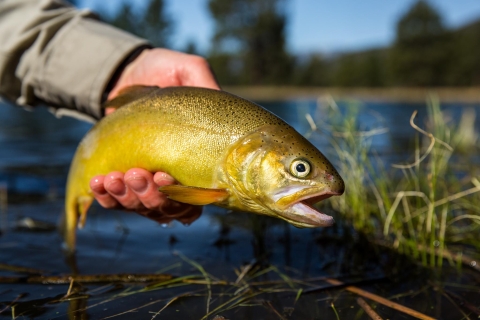ALBUQUERQUE, NM—The U.S. Fish and Wildlife Service (Service) is announcing the availability of a final revised recovery plan for the Gila trout, a species of trout found in small, high mountain streams in New Mexico and Arizona. The final recovery plan includes specific criteria for determining when Gila trout can be removed from the Federal List of Endangered and Threatened Wildlife and lists site-specific actions that will be necessary to meet those criteria.
The Gila trout is one of the rarest trout species in the United States. It was listed as endangered under the Endangered Species Act (ESA) in 1973. Successful efforts to restore populations resulted in the species being down-listed to threatened in 2006. Primary threats to the species are habitat degradation, and competition and hybridization with exotic fish species, most notably rainbow and brown trout.
An initial recovery plan for the Gila trout was finalized in 1979 and has been revised multiple times. Since that time, new information has become available on the species’ genetics, population status, and threats. The new revised recovery plan released today includes updated background and biological information on the species; a broad, prioritized list of recovery actions; objective, measurable delisting criteria; and estimated time and costs of recovery.
In order to promote and support the conservation and survival of endangered species and threatened species and provide a transparent path to achieving recovery, the Service and its partners develop and implement recovery plans.
Recovery plans are unique to each species and serve as central organizing tools that provide important guidance on methods of minimizing threats to listed species, such as restoring and acquiring habitat, removing introduced predators or invasive species invasive species
An invasive species is any plant or animal that has spread or been introduced into a new area where they are, or could, cause harm to the environment, economy, or human, animal, or plant health. Their unwelcome presence can destroy ecosystems and cost millions of dollars.
Learn more about invasive species , conducting surveys, monitoring individual populations, breeding species in captivity, and releasing them into their historical range. Recovery plans are guidance and not regulatory documents, and no agency or entity is required by the ESA to implement actions in a recovery plan.
The overall recovery strategy for the species involves preserving, restoring, and managing Gila trout habitat to support resilient populations of the species and the ecosystem on which it depends. This will entail incremental replacement of nonnative salmonids with Gila trout in suitable habitat throughout a significant portion of the historical range of the species.
As of April 2022, there were twenty-three populations of Gila trout inhabiting approximately 131 miles of stream habitat. There are currently five known genetic lineages of the species—Main Diamond Creek, South Diamond Creek, Whiskey Creek, Iron Creek and Spruce Creek—all of which are represented by at least three wild populations.
The final recovery plan for the Gila trout can be found at the following website: https://ecos.fws.gov/ecp/species/781




